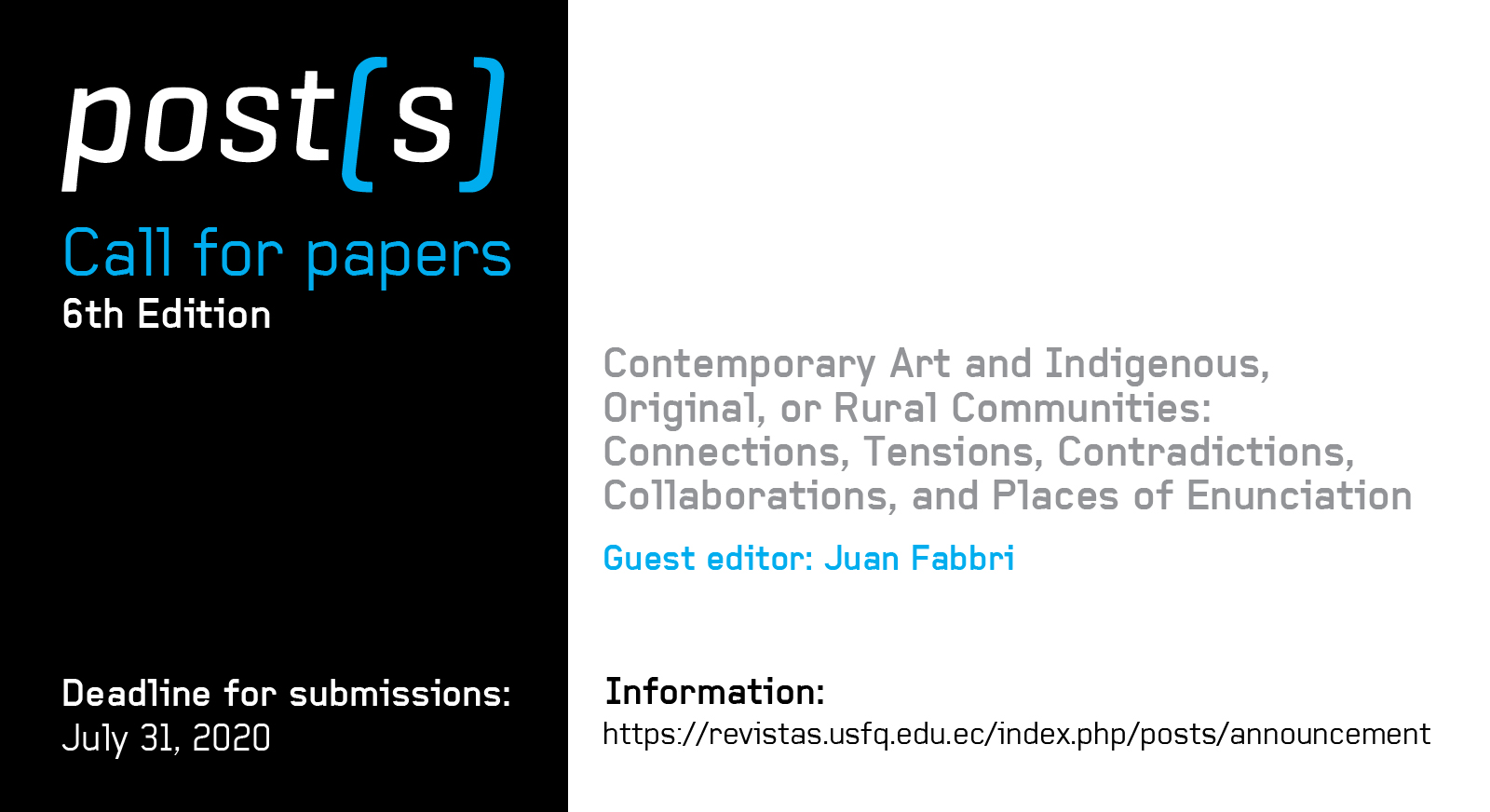post(s) 6: Contemporary Art and Indigenous, Original, or Rural Communities

For the sixth edition of post(s), we are accepting academic essays that examine problematics proposed by our new guest editor, Juan Fabbri. We continue to be interested in forms of creative writing, and also welcome submissions of visual essays and performance texts, particularly those presenting experimental methods for understanding the production of knowledge. The Call for Papers is open until July 31, 2020, and all proposals should be submitted through the OJS platform. For more details on the publication process, please visit the Information section.
Contemporary Art and Indigenous, Original, or Rural Communities: Connections, Tensions, Contradictions, Collaborations, and Places of Enunciation
"As indigenous we were conquered,
as indigenous we will free ourselves."
Popular Aymara Saying
Where is art produced? Who creates it? For whom is it intended? Who visits the exhibitions? Research on the politics of representation proposed by such authors as Stuart Hall, Edward Said, or Gayatri Spivak have influenced investigations into art and expanded dialogue on the place of enunciation for artists, investigators, and curators. Museums, cultural centers, galleries, biennales, and festivals"”aware that as a social practice their activities generate discourse"”have reevaluated their roles with respect to the politics of representation.
Historically, it was during the 1990s that discussions on globalization, growing cultural diversity, and multiculturalism began to emerge. Subsequently, after 2001, with the collapse of the World Trade Center and the United States invasion of the Middle East, there was increased recognition of cultural differences on a global stage, and the problematics concerning decolonization and cultural resistance received greater attention.
Our current state, marked by social protests, the impending destruction brought about by climate change, and the imperative to develop alternatives to capitalism, invites us to consider how art participates in social resistance, change, and acceptance. Bringing into question the politics of representation and the place of indigenous communities in the art world, this Call for Papers proposes that we reflect on ways of defining and practicing art within indigenous, original, or rural communities, for example, using an Indianist approach or ontological studies. Additionally, we want to assess how the artistic practices of historically excluded groups enter into conflict with Western definitions of art and question the hegemony of contemporary art. Such contexts have also rekindled debates on art, particularly indigenous art(s), artisanry, popular/folk art, or contemporary art; it is in this sense that current investigations and exhibitions on cultural elites and peripheries, legitimizations, and power relations have been conceived.
In Latin America, indigenous artists have invaded the contemporary art scene and transformed it into a place of enunciation for their own interests, for example, Maruch Santiz (Mexico), Amaru Cholango (Ecuador), Elliot Tupac (Peru), Bernardo Oyarzún (Chile), or José Ballivián (Bolivia). Other creators have appropriated, transformed, or investigated arguments regarding indigenous knowledge, for example, Ernesto Neto (Brazil), Diana Rico (Colombia), Anna Bella Geiger (Brazil), Sandra de Berduccy/Aruma (Bolivia), Ticio Escobar (Paraguay), Angélica Alomoto (Ecuador), among others. Also, intensifying debates during the 2000s turned to the existence of multiple cultural identities, which tend to be tense, conflictive, and asymmetrical relationships. The dismantling of binary readings of reality, such as indigenous versus the West or North versus South, have resulted in the development of new categories, for example, hybridity (García Canclini),Ch"™ixi(Silvia Rivera), or impurity and contamination (Gustavo Buntinx).
It is within this framework that we invite the community to ask: What strategies do indigenous, original, or rural artists utilize to discover discourses and platforms in contemporary art? How is contemporary art a place of enunciation for indigenous, original, or rural artists? What contributions has indigenous, original, or rural knowledge made to contemporary art? What are the power relations involved in the appropriation of cultural diversities in contemporary art? What are the possibilities for generating intercultural dialogues through art? How do indigenous, original, or rural communities interact with the hegemonic centers of reproduction in contemporary art, for example, international biennales? Under what circumstances are indigenous artists admitted into the universal history of art? What are the tools for the inclusion and exclusion of indigenous art or popular/folk art? How are indigenous, original, or rural peoples utilized, exoticized, or exploited in contemporary art? How do definitions and practices of contemporary art enter into conflict with indigenous, original, or rural notions of art? How are current debates concerning discussions on decolonization, decoloniality, or anticolonialism being considered in the art world?
For the sixth edition of post(s), we are accepting academic essays that examine these problematics and, continuing with our interest in forms of creative writing, we also welcome submissions of visual essays and performance texts, particularly those presenting experimental methods for understanding the production of knowledge.
Juan Fabbri is an artist, visual anthropologist, and curator. He is currently the National Director of Cultural Affairs for the Central Bank of Bolivia Cultural Foundation and a Research Fellow at the Institute for Anthropological and Archaeological Investigations at the Higher University of San Andrés. He was curator at the Bolivia Pavilion at the 57thVenice Biennale (2017, Italy), Bienalsur (2019, Argentina), and the Bolivia National Museum of Art (2016-2019) as well as the organizer of the seminar "Working Disobedience from Latin America" at the Tate Exchange (2020, England). He is interested in the intersections, connections, and tensions between anthropology and contemporary art.
